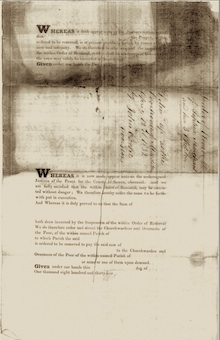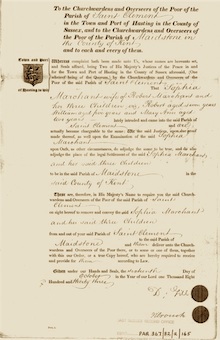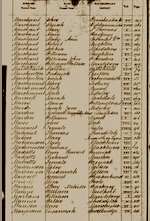.gif) | |
Jones |
|
The "Jones" surname descends from two distinct strands—a Welsh lineage and an English lineage. It's a patronymic name from the Middle English personal name Jon(e). The surname is especially common in Wales and southern central England.
The English strain was first found in Lincolnshire, borne by Alanus filius Jene in 1275. The Coat of Arms: A silver shield with through black cornish choughs. The Crest features two battle axes in saltire proper.
The English branch that we descend from can be traced back to JOHN JONES, born in early 1752 in Hastings, Sussex, England. John married MARY FERRELL on 30 Jun 1788 in Herstmonceux, a village and civil parish in the Wealden District of East Sussex, England.
The Ferrell surname is Irish, and means "hero," or "man of courage." It is an anglicized version of the noble 15th-century Irish Gaelic surname Ó Fearghails ("descendant of Fearghal"), derived from a family who retook leadership of the region from the English. The family Coat of Arms and Crest is distinguished by a Golden Lion rampant, which signifies Bravery, Nobility, Glory, Strength and Courage on a green field, which signifies Hope, Joy and Love. The golden colour denotes generosity and elevation of mind. The crest is a ducal coronet with an unleashed hound—'Cú reubha'—which translates to "The Hound Unleashed," which symbolizes having broken from the hold of all oppressors (in mythology the hound is often used as an epithet to describe a valiant warrior). The surname was first found in Leinster, where they were found mainly in County Longford. Feargal, Prince of Annaly appears number 105 on the "Line of Ir" descendants.
| Marriage Bann |
Image
|
| Denomination: |
|
Church of England |
| Place: |
|
Herstmonceux, Sussex, England |
| Date: |
|
29 Jun 1788 |
| Page: |
|
33 |
| Banns No.: |
|
164 |
| Engaged: |
|
Hannah Jones, John Brazil |
| Banns No.: |
|
165 |
| Engaged: |
|
John Jones, Mary Ferrell |
|
|
|
SOURCE INFORMATION: Church of England Parish Registers. Brighton, East Sussex, England: East Sussex and Brighton and Hove Record Office. East Sussex Record Office; Brighton, England; Sussex Parish Registers; Reference: PAR 399/1/1/6.
|
John and Mary were probably "Travellers," an ethno-cultural group something like gypsies, but of Irish extraction.¹ Travellers likely diverged from the settled Irish population during the time of the Cromwellian conquest of country, and centuries of cultural isolation led Travellers to become genetically distinct from the settled Irish. There are numerous theories and oral histories surrounding the origins of Irish Travellers as a distinct group. Research has been complicated by the fact that the group appears to have no written records of its own, with oral tradition through storytelling being the primary method through which the Traveller community disseminates its own history and culture.
John and Mary were wed on the same day as John's probable sister, Hannah Jones, who was wed to a man named John Brazil, which is another well-documented traveller surname in Sussex. The Brazils were called "travellers" and "beggars" in later baptisms of their children.
The children of John and Mary were:
CHILDREN OF JOHN JONES AND MARY FENNELL
|
| ELEANOR FERRELL was baptized on 29 Feb 1784 in Salehurst, Sussex, England. Eleanor was listed as 14 days old when she was baptised and was born out of wedlock; She is called "the bastard daughter of Mary Ferrell." (It is unknown if John Jones was the actual father.) Eleanor Ferrell then married a William Bryant in Rolvenden on April 9th 1809 and they settled there.
|
|
ROSEANNA JONES was born around 1801. Her age in 1841 is given as 40 (but that may well have been rounded down, so she could have been born some time between 1796 and 1801. On 3 May 1819 she married George Balcomb (1797-1828) in Rolvenden, Kent, England. George is of Cranbrook, while Roseanna is listed "of this parish." The witness at their marriage is William Bryant, the husband of Roseanna's half-sister, Eleanor. Roseanna helped Sophia raise her children in the absence of Robert Marchant, and eventually even Sophia, both in and out of the workhouses.
|
| SOPHIA JONES was baptized on 14 Feb 1807 in Salehurst, Sussex, England. She married ROBERT MARCHANT (b. 29 Dec 1803) on 27 Nov 1825 at All Saints parish in Maidstone, Kent, England. Family listed below. She died in 1839.
|
|
HENRY GEORGE JONES was baptized in nearby Bodiam on 24 Nov 1811.
|
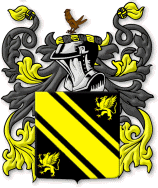 | | Marchant |
|
The names "John Jones" and "Mary" are a common combination in Sussex baptismal records, so Elijah (Mayfield 1793), John (Framfield 1788), Mary Ann (Fletching 1797), John (Horsham 1806 but very close to Sophia), John (Hastings 1810) are also possible children. What we can be sure of is that their daughter SOPHIA JONES was baptized on 14 Feb 1807 in Salehurst, Sussex, England. She married ROBERT MARCHANT (b. 29 Dec 1803) on 27 Nov 1825 at All Saints in Maidstone. Robert was a lath render, but as work became more scarce during the 19th Century, Robert took to the ways of Sophia's family, and the family had to move around while Robert searched for jobs, and sometimes new occupations. Over the course of his life Robert would be listed as a lath render, a lather renderer (a worker who covered the laths with a plaster concoction of lime and horse hair on walls & ceilings), a general laborer, a pedlar, and a hawker (crier) in various places around Kent and Sussex counties. Consequently, Robert and Sophia had children born in the towns of Maidstone, Northiam, Rochester, and Hurstpierpoint. Their children were:
CHILDREN OF SOPHIA JONES AND ROBERT MARCHANT |
| ROBERT MARCHANT was born on 10 Jan 1826, and was baptized at St Margaret's, Rochester, on Feb 19th. On 30 Mar 1855 he married (1) Sarah Anna Greenwood (1835-1866) and they had the following children: Maria Anna (1856-1862), Joseph Thomas (1859-1859, William Henry (1860-1861), Robert (1862-1862), Margaret Ann (1863-1869), and Sophia (1865-1866). None of the children lived into adulthood. When Sarah passed away in 1866, Robert remarried to (2) Elizabeth Lambert (1841-1891) in St Vincent de Paul, Lancashire on 14 Oct 1866 (click on the church record, at right). They had the following children: Robert Joseph (1867-1940), Mary (1869-1954), George (b. 1870), Henry Stephen (b. 1872), Thomas (b. 1876), Elizabeth Marchant (b. 1882). In the 1901 England census, he is a widower living with daughter Mary (1869-1954) and her husband, Michael Henry Sarsfield (1867-1938). Robert died in Apr 1909 in Liverpool, Lancashire, United Kingdom. See a genealogy of his descendants here. |
| WILLIAM MARCHANT was born on 8 Jun 1828, and christened on 29 June 1828 at Northiam, Sussex. He joined the Royal Canadian Rifles and married MARTHA LOUISA READ (1832-1886). Family listed below. After the death of his wife, he returned to England. In the 1891 census of England, he is living with his brother Robert in Liverpool. He's a widower and his death certificate from 16 Dec 1896 quotes his occupation as an army pensioner. He is buried in the Church of England section of Anfield Cemetery in Liverpool (238 Priory Road, Anfield, Merseyside England, Postal Code: L4 2SL)." |
| HENRY MARCHANT (1) was baptized on 19 Feb 1830 at All Saints, Maidstone, Kent, England to Robert and Sophia Marchant. (England, Births and Christenings, 1538-1975. Salt Lake City, Utah: FamilySearch, 2013; FHL Film Number: 1835448; Reference ID: p 154, 1229.) He died as an infant. From the Sussex Advertiser on Monday, 12 April 1830, page 3, column 4: "On Wednesday, at Crowborough Gate, on view of the body of Henry Marchant, an infant about ten weeks old. The mother was on her way from Brighton to Maidstone with the deceased, and upon her arrival at the gate at Crowborough, discovered the child to be dead. It has always been in a very unhealthy state. Verdict—Died by the visitation of God." Burial Date: 12 Apr 1830 at All Saints, Maidstone, Kent, England (England Deaths and Burials, 1538-1991. FHL Film Number 1835448, p 228, 1820.) |
| MARY ANN MARCHANT was baptized on 07 Aug 1831 in Hurstpierpoint, Sussex, England to Robert and Sophia Marchant. (England, Births and Christenings, 1538-1975. Salt Lake City, Utah: FamilySearch, 2013; FHL Film Number: 416747) She also traveled to Canada, like her brother William, and settled in St. Catharine's. She married GEORGE BARR (b. 1831) of Scotland Village on 10 Sep 1861 in Lincoln, Ontario. "Sept. 10: George Barr, Private in H. M. Royal Canadian Rifle Regiment, and Mary Anne Marchant, both of St. Catharines; witnesses: Mary Illsey, Charles Illsey, Corpl. R. C. R.; by Thomas T. Robarts." (SOURCE: St. George's Parish Church, St. Catharines, Jubilee celebration and historic and centenary review, by Robert Ker, St. Catharines, Ont.: Star Print. 1892. p. 133) She and George (Barr) came back to Scotland where he was born and he became a spirits merchant. They're on the 1871 and 1881 censuses. He died 1887. She died in 1895 from cirrhosis of the liver. |
| ELIZABETH MARCHANT was baptized on 12 May 1837 in Maidstone, Kent, England to Robert and Sophia Marchant. (England, Births and Christenings, 1538-1975. Salt Lake City, Utah: FamilySearch, 2013; FHL Film Number: 1835449) She died in 1841. ("England and Wales, Death Registration Index, 1837-1920", Volume 5, page 222, line 14. Elizabeth Marchant: Oct-Nov-Dec 1841; Maidstone, Kent, England.) Records for Maidstone Union (which cover the period 1835 to 1841) show Elizabeth Marchant born on 21 April 1837 to Sophia Marchant (Legitimate) and Baptised on 12 May 1837. The Burial Register shows Elizabeth Marchant buried on 22 November 1841, when four years old in Linton, a village and civil parish in the Maidstone District of Kent. |
 |
HENRY MARCHANT (2) was baptized on 12 May 1837 in Maidstone, Kent, England to Robert and Sophia Marchant (England, Births and Christenings, 1538-1975. Salt Lake City, Utah: FamilySearch, 2013; FHL Film Number: 1835449; Reference ID: 1 64 506), He was baptized at same time as Elizabeth, but there's no evidence that they are twins. A Henry Marchant aged 7 is in the workhouse in 1841. Henry survived the workhouse and became a cordwainer/shoemaker. He married Mary Jane Brailsford Holness in 1857 and they had 4 children: Eliza, Mary Ann, Henry and Elizabeth. Henry Jr., died as an infant in 1861 and Mary Jane (wife/mother) died soon after the birth of Elizabeth in 1862. They lived with Mary Jane's parents in Dover and Eliza and Mary are still there in 1871. Elizabeth was then with a great uncle and aunt nearby. Henry seems to have disappeared. When Eliza married in 1876 her marriage certificate says Henry is deceased. There is a newspaper report of the sudden death of a shoemaker named Henry Marchant in Reading (Berkshire) in 1869. He was buried in consecrated ground (like William) in London Road Cemetery, Wokingham on 29 Sep 1869 (Berkshire Burial Records). See a genealogy of his descendants here. |
| Burial Record |
Image
|
| Name: |
|
John Jones |
| Age: |
|
77 |
| Abode: |
|
St. Clement, Hastings |
| Death Date: |
|
1835 |
| Burial Date: |
|
3 Aug 1835 |
|
|
|
SOURCE INFORMATION: Church of England Parish Burial Registers. Brighton, East Sussex, England: East Sussex and Brighton and Hove Record Office.
|
Eighteenth and nineteenth-century Britain was dependent on seasonal and "tramping" labor and travelling Irish like the Marchant, Jones and Ferrell families would sojourn to Kent for the harvest season in September, or to the market gardens of South East England, to find work or sell their wares. Robert Marchant fit right in with the Jones family, as he was described as a "pedlar" and "hawker" in the baptismal records of his children, but he also specialized in lath rending—the family trade—for building homes, and creating materials to use on the canals and railways for navigators. At the end of the harvest in September, a traditional End End "holiday" was a welcome period of high wages for all, and then lodging had to be secured for the cold winters. The local residents considered those crowded areas dangerous and crime-ridden. Pedlars and hawkers then set off in April and May to carry their goods to isolated rural areas.
Being poor in British society was not only a tough, grueling existence, it was also illegal! By the letter of the law, and in the absence of a well-filled purse, a pass of some kind, whether a pedlar's license or a vagrants' or soldiers' pass, was needed to secure your way across the unwelcoming English countryside. The Vagrancy Acts of 1744 and 1821 formed the legal framework within which many a wandering laborer was forced to operate, and those who fell foul of the laws were punished by whipping or a stint in the house of correction.
But the 1834 "Poor Law" changed all of that and ensured that the poor were housed in workhouses, clothed and fed. Children who entered the workhouse would receive some schooling. In return for this care, all workhouse paupers would have to work for several hours each day. John Jones passed away in 1835 along with the nomadic traveller lifestyle, and was buried at St Clement's Church in the Old Town Parish of Hastings. But Sophia and her family still had many run-ins with the law—and with the poor houses—and it is a very sad story.
| Personal Information |
Removal Order
|
| Name: |
|
Sophia
Marchant |
| Spouse: |
|
Robert
Marchant |
| Children: |
|
Robert (6) William (4), Mary (8 mos.) |
| Date: |
|
10 Apr 1832 |
| Parish: |
|
St Michael |
| Town: |
|
Lewes |
| County: |
|
Sussex |
| ESRO: |
|
414/32/2/89 |
|
|
|
| Personal Information |
Removal Order
|
| Name: |
|
Sophia Marchant |
| Spouse: |
|
Robert Marchant |
| Children: |
|
Robert (7)
William (5)
Mary Ann (2) |
| Date: |
|
16 Oct 1833 |
| Parish: |
|
St. Clement |
| Town: |
|
Hastings |
| County: |
|
Sussex |
| ESRO: |
|
367/32/2/165 |
|
|
|
|
|
SOURCE: East Sussex Records Office/The Keep, Woollards Way, Brighton, East Sussex BN1 9BP; Phone: 01273 482349. National Archives: Lewes / Hastings. |
"No wonder that the lower classes dread the very name of the Poor Law,—no wonder that they look upon the Union house as worse than a prison, and that in fact many rather than become the inmates of a workhouse, commit some petty felony that they may obtain, to them, a far lighter punishment—incarceration in a gaol (jail)!"
—"Extracts from the Diary of a Workhouse Chaplain," by the Rev. D. L. Cousins, A.M. London: J. Hatchard and Son, 1847.
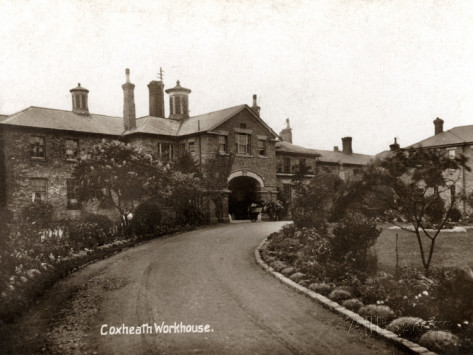
"Coxheath Poor Law Union" Workhouse site (renamed Maidstone Union Workhouse in 1836), from the north-east, c.1905. © Peter Higginbotham.
|
In 19th-Century England, parishes were legally responsible for looking after their own poor. This was funded by the collection of a poor-rate tax from local property owners. Workouses were then created to provide work for the unemployed able-bodied (with the threat of prison for those who refused). They also provided housing for orphans and the "impotent poor" (the elderly, chronic sick, etc.) The Marchant family would eventually qualify for all of those categories.
Maidstone was the location of the "workhouse" where Sophia and the children were sent. The Maidstone Union Workhouse was built in 1836 at a site to the south of Heath Road in Coxheath "for 600 paupers." The design was of plain brick construction and comprised a large quadrangle enclosed by two-story buildings. A further building, thought to be the workhouse school, were erected nearby at the north side of Heath Road. The dormitory blocks, which were referred to as 'cottages' measured 15 feet by 10 feet, lit by a small window. There was a single ground-floor privy on each side of the courtyard.
Workhouses looked like prisons from the outside, and life inside them was miserable—and intentionally so. The government, terrified of encouraging 'idlers' (lazy people), made sure that people feared the workhouse and would do anything to keep out of it—including stealing pork and risking imprisonment, like Robert.
Here is what our ancestor William Marchant, a child under ten years of age, faced in the workhouse:
|
LIFE IN THE WORKHOUSE
|
|
Upon entering the workhouse, the Marchant family would have been immediately separated, and Sophia would only have been allowed limited contact with her children—perhaps for an hour or so a week on Sunday afternoon. William and his siblings had to rely on each other to survive.
William's clothes were removed and stored. He was searched, his hair was cropped, and he was bathed (under supervision). Supervised baths were then given once per week.
He was made to wear a uniform, so that every inmate looked the same, and everyone outside knew he was poor and lived in the workhouse. William was given a striped shirt, ill-fitting trousers (the length being adjusted at the knee with a piece of string), thick vest, woollen drawers and socks, a neckerchief and (in winter) a coarse jacket. Sophia and the girls were given a shapeless, waistless dress which reached the ankles, made of striped (convict-style) fabric, a shapeless shift, long stockings and knee-length drawers, and a poke-bonnet. All the inmates were given hob-nailed boots.
Women, children and men had different living and working areas in the workhouse. Married couples, even the elderly, were to be kept apart at all costs so that they could not 'breed'. They could be punished if they even tried to speak to one another.
Although the workhouse was required to provide free education and job training for William, the education he actually received would not have included reading and writing—which were the two most important skills needed to get a good job.
The food in his meals was tasteless, and they rarely changed. Commonly, the meal would have been gruel, which is a thin food made by boiling oatmeal or some other grain in water. Other base ingredients to boil could include breadcrumbs or ground crackers. Often the quantity, quality and lack of nutrition meant that workhouse inmates were on a slow starvation diet.
William's 'work' would have consisted of stone-breaking, bone-crushing, sack-making, driving the corn mill, or picking apart "oakum" (old ropes), sometimes tarred or knotted. These ropes had to be unpicked inch by inch and a day's work would be to unravel 3 lbs. of rope. The corn mill was driven by inmates walking round on a treadwheel. (Women had to do domestic work: scrubbing floors and tables, polishing brasses, black-leading kitchen ranges, and so on.)
William could also find himself 'hired out' to work in factories or mines.
|
| Article Information |
Newspaper
|
| Newspaper: |
|
Maidstone Gazette and Kentish Advertiser |
| Date: |
|
Tuesday 03 December 1839 |
| Page: |
|
4 |
| Column: |
|
3 |
| Title: |
|
Police |
| Date of sentencing: |
|
30 Nov 1839 |
|
|
|
|
|
SOURCE INFORMATION: The British Library, 96 Euston Rd, London NW1 2DB; Maidstone Gazette and Kentish Advertiser for Kent, Sussex, Surry, and Essex, #2801 (full page).
|
Despite their rocky relationship and forced separation in the workhouse, Robert and Sophia were out of Maidstone Union long enough to have two more children, Henry (b. 1834) and Elizabeth (1837-1841). But Robert never found steady work, and they always seemed to end up back in the workhouse. Life was hard for everybody—the average life span of people around London at this time was 27 years, but for members of the working class, that number dropped to 22. In the workouse, however, life itself was seen as a burden on society, and as a result the buildings were filled with misery, rampant disease, and death, from which the Marchant family would not be spared: William's mother became ill in 1839, while in the workhouse. She would have been housed separately in a sick-ward, with no visitors allowed, including William and the other children. The workhouse sick-ward took in all cases, so at any one time there may have been patients suffering from any variety of complaints ranging from broken legs, measles, typhoid fever and smallpox to blindness, scarlet fever, diphtheria and dysentery. It was the worst place for a sick person to be.
|
| Personal Information |
Death Record
|
|
| Name: |
|
Sophia Marchant |
| Year: |
|
1839 |
| District: |
|
Maidstone |
| County: |
|
Kent |
| Volume: |
|
5 |
| Page: |
|
213 |
|
|
|
|
SOURCE INFORMATION: General Register Office. England and Wales Civil Registration Indexes. London, England: General Register Office.
|
|
Sophia Jones Marchant passed away in October of 1839 in the Maidstone workhouse, leaving five children between the ages of two and 12 to fend for themselves.⁴ Rosanna Balcomb, a widow and possibly Sophia's sister, had been sent back with Sophia to Maidstone from Sussex, and it's likely that she kept an eye on the children after Sophia died.
Robert Sr. wasn't around to watch over the children. In fact, the Maidstone Journal and Kentish Advertiser of Tuesday 3 Dec 1839 reported that a Robert Marchant was convicted of deserting his wife and family, and sentenced to three months imprisonment in the house of correction. While we can't be sure if this particular Robert is our ancestor, we do know that Robert soon left Kent and moved to Surrey—where there was more work, and where his brother was already living, in the London borough of Lambeth, where he passed away in January of 1884.
NOTES ON THIS PAGE
¹—Paul Harrington (Sun, Aug 20): "Here's a reasonable chronology:
- 1784 Mary Ferrell had a daughter out of wedlock baptised 29th February in Salehurst. Eleanor was 14 days old when she was baptised and is called the bastard daughter of Mary Ferrell.
- 1788 June 30th Mary Ferrell married John Jones at Herstmonceux. Above John and Mary in the records, married on the same day, are John Brazil and Hannah Jones. This caught my eye because Brazil is a well documented traveller name in Sussex. That they were travellers is confirmed by later baptisms.
- In 1789 July 19th they have a daughter Elizabeth baptised at Guestling when they are called 'beggars.'"
- In 1799 February 13th they have a son John baptised at Sedlescombe when they are called 'travellers of Penshurst in Kent married at Hurstmonceux'. Interestingly, they are not defined by their status when they have a John baptised in 1792 July 15th at Salehurst. We have suspected for some time that Sophia's family were travellers. Based on names, and the proximity of the marriages, the John and Mary who married at Hertstmonceux on the same day as John and Hannah are also likely to be travellers. Hannah is probably John's sister. The name Hannah is interesting in that Rose Jones is Rosanna or Rosannah in the records. Her name seems to be a combination of Rose and Hannah.
- 1808 9th April Eleanor Ferrell married William Bryant in Rolvenden. They settled and had a family there and were living there in 1819.
- 1819 George Balcomb and Rose Jones were married May 3rd at Rolvenden. George is of Cranbrook. Rose is of this parish. The witness at their marriage is William Bryant.
I don't think we'll get better 'provenance' than this. Eleanor Ferrell Bryant is the answer to the question 'why did George Balcombe and Rose Jones go to Rolvenden to marry?' She must be. It's not credible that it is just a coincidence her husband is the witness at George and Rose's marriage. Mary Ferrell is her mother and Rose's mother. She is Rose Jones' full, or half, sister. So it looks like:
- Rose (baptism not found; died 1841; There is a Rose d. of a John and Mary Jones baptised in Maresfield Dec 5th 1790;—but this would put her aged 50 in the 1841 census if she's 'our' Rose. Too vague to verify as yet.) and Sophia Jones (baptised 15th February 1807 at Salehurst; died age 32 in Maidstone workhouse 1839) are the daughters of John Jones and Mary Ferrell. John Jones may or may not be Eleanor's father.
- Henry George Jones baptised Bodiam 24th November 1811 to John and Mary is their brother. His, and likely their, father is a hawker. He says this at his marriage.
There are other births to a John and Mary that could well be other siblings, but nothing, beyond the fact they are one-off births in a location, necessarily says they are:
1788 Framfield 19th October John born to John and Mary. They are said to be paupers.
1797 Fletching 30th July Mary Ann of John and Mary. They are said to be 'of Ticehurst.'
1806 Horsham 10th August John of John and Mary. He is in the 90th Regiment. (This would need to be a late baptism as Sophia is baptised the following February)
1810 Hastings All Saints 15th April John Jones of John and Mary.
Numerous gaps in the births but as we discovered gaps are also there in the Marchant family. John and Sarah Marchant, Robert's parents, have a gap of 7 years. We've always assumed this must be connected to military service during the Napoleonic Wars."
²—Paul Harrington (Sun, Aug 20): "The police report suggests that Sophia had some means of living in the area and was probably in touch with relatives before moving on to Lewes where Rbt was in prison. We know they travelled extensively around Sussex so connections with families (mixed spellings) such as Jones, Ferrell (many confused transcriptions), Bryant, Brazil, Coney etc keep cropping up. Branches of Jones and Ferrells were carpenters and builders and this was railway building boom time—so work available for lath renders (or a chance for villains to take advantage of crowds of strangers?)"
TOP PHOTO: SALEHURST (St. Mary), a parish, in the union of Ticehurst, hundred of Henhurst, rape of Hastings, E. division of Sussex, 6 miles (N.) from Battle. A Cistercian abbey was founded here in 1176, by Alured de St. Martin and Queen Adeliza, and flourished till the Dissolution. The river Rother flows through the parish; and the road to Hastings passes by the villages of Robert's-Bridge and HurstGreen: at the latter beautiful place, petty-sessions are held monthly. The church is a handsome structure in the early and later English styles, with a square embattled tower, and contains some remains of stained glass. There are places of worship for Wesleyans.
LITERARY SOURCES FOR THIS PAGE:
The British Gypsy and Traveller Communities
Hitchcock, Tim, Down and Out in Eighteenth-Century London (London, 2004).
Mayall, David, Gypsy-Travellers in Nineteenth-Century Society (Cambridge, 1988).
Mayall, David, English Gypsies and State Policies (Hatfield, 1996).
Samuel, Raphael, "Comers and Goers" in H.J. Dyos and Michael Wolf, eds, The Victorian City, Images and Realities, vol. 1 (1973), pp.123-160.
GENEALOGY
JOHN JONES (1752 - 1835), who married MARY FERRELL (1753 - 1815) and begat...
SOPHIA JONES (1807 - 1839), who married ROBERT M MARCHANT (1804 - 1884) and begat...
WILLIAM MARCHANT (1828 - 1896), who married MARTHA LOUISA READ (1832 - 1886) and begat...
WILLIAM HENRY MARCHANT (1850 - 1896), who married MARTHA HOLLAND (1852 - 1911) and begat...
MARJORIE MARCHANT (1892 - 1939) who married CARLISLE HAUSE (1891 - 1972) and begat...
CARLETON MARCHANT HAUSE SR. (1917 - 1983) who married JEANNE MAY BRUNNER (1918 - 2000) and begat...
CARLETON MARCHANT HAUSE JR. (b. 1939) who married MARTHA WENK (b. 1940) and begat...
JEFF (who married LORI ANN DOTSON), KATHY (who married HAL LARSEN), ERIC (who married MARY MOONSAMMY), and MICHELE HAUSE (who married JOHN SCOTT HOUSTON).
COUSINS, COLLABORATORS & CO-CONSPIRATORS...
|
|
PAUL HARRINGTON is the great-grandson of William Marchant's brother, Robert. "Robert went to sea (boys from the workhouse often joined the army or the merchant navy). He ended up in Liverpool where he married a Sarah Greenwood in 1854. Their children died in infancy and Sarah died in 1866. Then Robert married Elisabeth Lambert (our great grandmother)." Robert's daughter, Mary, married a Michael Sarsfield in 1891. "We family searchers—cousins Julie (Callanan), Michael and myself—are children of three of their daughters: Nora (1913-2007), Eileen (1905-1993) and Winifred (1901-1994). Winifred married Philip Harrington in 1930, and they had Margaret (1931-2000), Philip (b. 1938-) and myself (b. 1943). By my reckoning that makes my grandmother Mary 1st cousin to William H Marchant; my mother Winifred 2nd cousin to Lillie and Marjorie; and I'm 3rd cousin to Gretchen and Carlton Sr." See Paul with wife Jean by clicking on the photo at right.
|
|
|



.gif)









